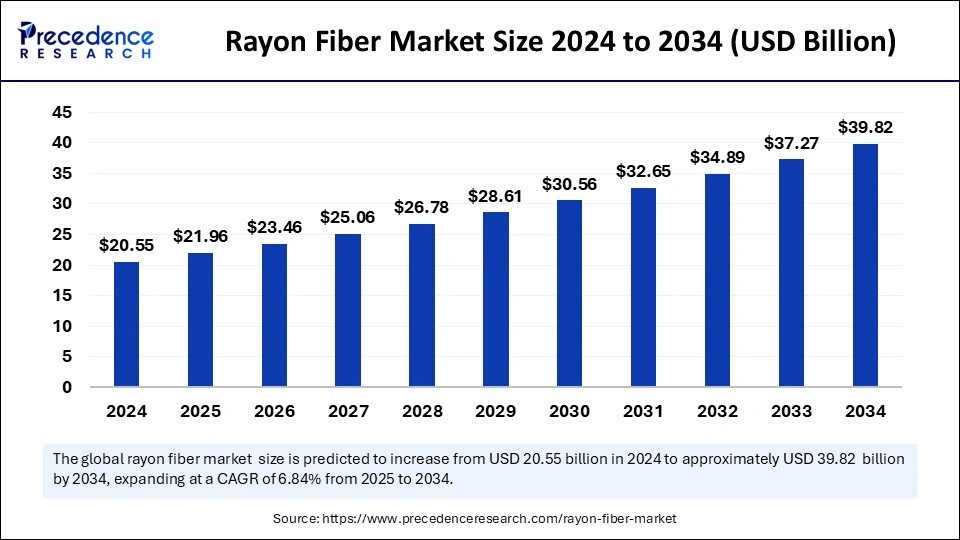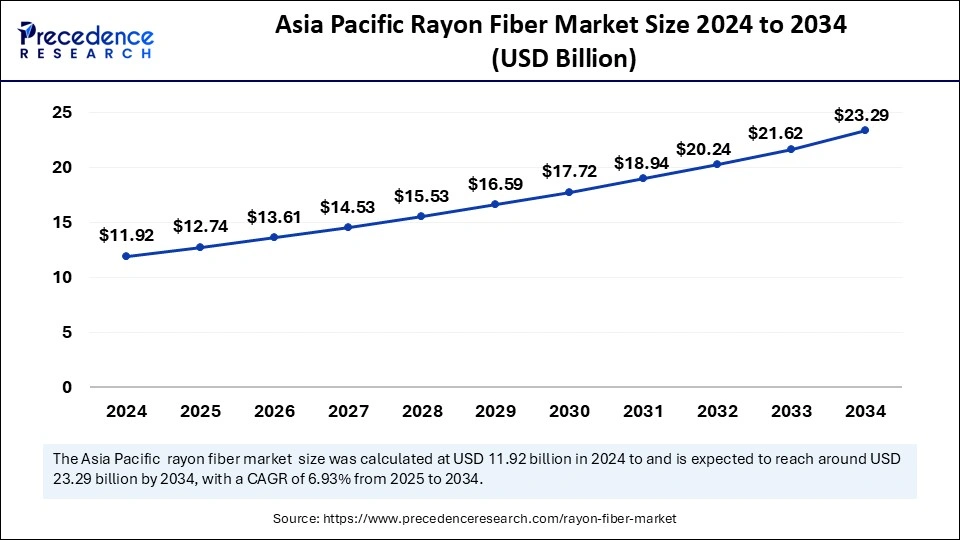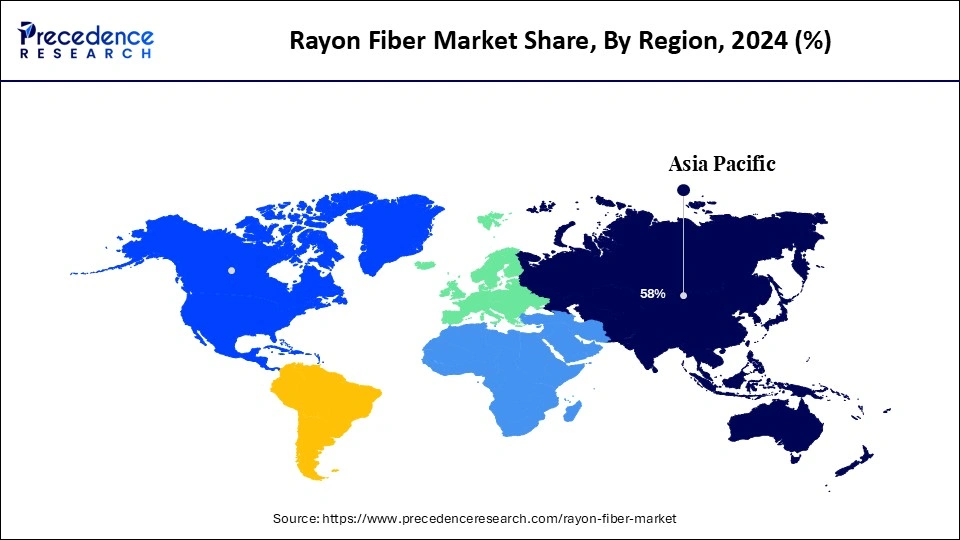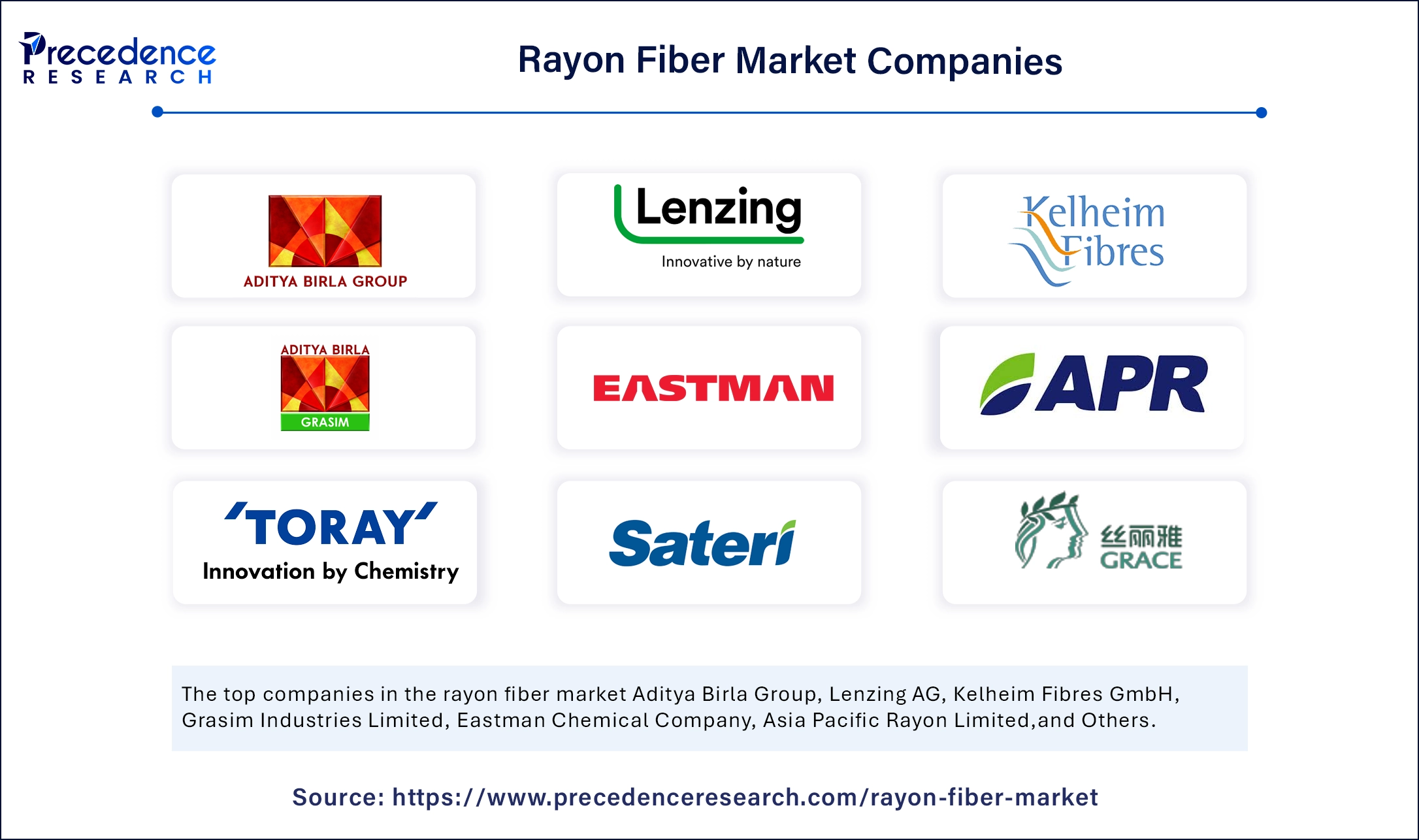April 2025
The global rayon fiber market size is accounted at USD 21.96 billion in 2025 and is forecasted to hit around USD 39.82 billion by 2034, representing a CAGR of 6.84% from 2025 to 2034. The Asia Pacific market size was estimated at USD 11.92 billion in 2024 and is expanding at a CAGR of 6.93% during the forecast period. The market sizing and forecasts are revenue-based (USD Million/Billion), with 2024 as the base year.
The global rayon fiber market size was calculated at USD 20.55 billion in 2024 and is predicted to increase from USD 21.96 billion in 2025 to approximately USD 39.82 billion by 2034, expanding at a CAGR of 6.84% from 2025 to 2034. The rayon fiber market is expanding rapidly due to the increasing disposable income in emerging countries and heightened awareness of the availability of eco-friendly options in clothing.

Artificial Intelligence significantly revolutionizes the rayon fiber market. Integrating AI technologies in the production process can lead to higher yield and reduced waste. AI analyzes the properties and qualities of raw materials and identifies defects, leading to the production of high-quality rayon fibers. AI also helps analyze consumer preferences and current trends in the textile industry. For instance, Adobe Textile Designer is a tool that uses AI to analyze vast datasets regarding current trends in the fashion industry and consumer buying behavior in online retail platforms. With the help of such analysis, manufacturers can predict future trends, enabling them to manage inventory levels accordingly.
The Asia Pacific rayon fiber market size was exhibited at USD 11.92 billion in 2024 and is projected to be worth around USD 12.74 billion by 2034, growing at a CAGR of 6.93% from 2025 to 2034.

Asia Pacific held the largest share of the rayon fiber market in 2024. The growth of the rayon fiber market in Asia pacific can be attributed to the abundance availability of raw materials, such as cotton and wood pulp, boosting the production of rayon fiber and making the production cost-effective. Countries like India, China, and Bangladesh are major contributors to the market as they provide these raw materials in abundant amounts. The rapid expansion of the textile industry further supports market growth. Moreover, governments around the region are supporting the textile industry and promoting sustainable raw materials to bring innovations that contribute to reginal market growth.
North America is seen to grow at the fastest rate in the rayon fiber market during the forecast period. The regional market growth is driven by the heightened demand for sustainable textiles. The textile industry in the region is actively seeking a sustainable approach to lower carbon emissions and comply with stringent regulations. The region has a well-established apparel and textile sector, supporting market growth. Moreover, North American consumers have become more aware of the availability and benefits of environmentally friendly and biodegradable materials, boosting the demand for rayon fiber over synthetic options for apparel.

The U.S. accounted for the maximum share. The market in the country is proliferating owing to the growing preference of consumers for eco-friendly and sustainable textiles, which are obtained from natural sources like wood cellulose that can be easily degradable in nature. Ongoing advancements in textile manufacturing technologies further support market growth. There is a high demand for clothes and home textiles, which is expected to propel the growth of the market.
The demand for rayon fibers is increasing in the apparel industry due to their unique properties like biodegradable nature and eco-friendliness. By offering a renewable alternative, rayon aligns with sustainability goals that enterprises are looking for. Due to growing environmental concerns, many consumers and textile manufacturers are opting for eco-friendly materials than synthetic fibers like polyester, which are harmful to nature due to their slow process of degradation. Moreover, the increasing popularity of blended fabrics and the rising demand for high-quality, comfortable attire are contributing to the growth of the rayon fiber market. There is a high demand for nonwoven and medical textiles, creating immense opportunities for market growth.
The growing demand for surgical gowns, medical wipes, and disposable garments are expected to boost the growth of the market during the forecast period. In addition, the increasing demand for rayon fabric in aerospace and automotive applications for interiors, like seat covers, due to their flame resistance and moisture absorption properties, is driving the market growth. Rayon fiber is also suitable for technical textiles due to its properties like high breathability and insulation, bolstering its adoption on a large scale.
| Report Coverage | Details |
| Market Size by 2034 | USD 39.82 Billion |
| Market Size by 2025 | USD 21.96 Billion |
| Market Size by 2024 | USD 20.55 Billion |
| Market Growth Rate from 2025 to 2034 | CAGR of 6.84% |
| Dominated Region | Asia Pacific |
| Fastest Growing Market | North America |
| Base Year | 2024 |
| Forecast Period | 2025 to 2034 |
| Segments Covered | Material Type, Application, and Regions |
| Regions Covered | North America, Europe, Asia-Pacific, Latin America and Middle East & Africa |
Expanding Textile Industry and R&D
The rapid expansion of the textile industry is driving the growth of the rayon fiber market. The demand for home textile, apparel, and nonwoven for industrial applications is rising, which further boosts the demand for different fibers, including rayon. To enhance rayon properties and expand the scope of applications beyond textiles, key players operating in the market are investing heavily in research and development, contributing to market growth. Moreover, consumers are looking for more comfortable yet stylish outfits. Clothes made from rayon fibers are extremely soft and hence offer super comfort. Innovative methods like the cellulose easter and viscose method are enhancing the quality and characteristics of rayon fibers, including absorbency, breathability, softness, and dyeability.
Fluctuating Raw Materials Prices and Environmental Concerns
Rayon is primarily derived from wood pulp. Deriving large quantities of rayon requires abundant wood pulp, leading to rapid deforestation. This, in turn, increases environmental concerns. Along with this, the production process of rayon requires large amounts of water and causes the depletion of finite natural resources. Moreover, harmful chemicals like hydrogen sulfide are used as a byproduct in manufacturing, increasing concerns regarding chemical waste. While rayon fibers are better than synthetic fibers, they cannot surpass the benefits of pure fibers. The availability of wood pulps is subject to price fluctuations. Such factors significantly increase production costs and hinder the growth of the market.
Increasing Disposable Income and Shift Toward Luxury Lifestyles
The increasing disposable income and rapid shift toward luxury lifestyles create immense opportunities in the rayon fiber market. As consumer disposable income rises, so does the willingness of people to spend on clothing and styling with comfort and affordability. Rayon fibers present great options for such consumers, as they serve the purpose of breathability and vibrant clothing according to the trending fashion. Rayon fiber is further used in home decoration like curtains, upholstery, and bedsheets, creating a strong foundation for the rayon fiber market to expand its roots on a wider scale.
The viscose rayon fibers segment held the largest share of the rayon fiber market in 2024. The segment growth is primarily driven by its offerings like softness, exceptional drapes, and breathability, which make it a popular choice among consumers looking for stylish yet comfortable and vibrant attire. Viscose rayon is used to manufacture various garments, like shirts, blouses, and sportswear. In addition, viscose rayon fiber is more affordable compared to other silks, along with its ability to blend with other fibers, enhancing characteristics like luster and softness.
The modal rayon fibers segment is expected to witness the fastest growth in the coming years. The segment growth can be attributed to their unique properties like moisture-wicking tendency, breathability, and lightweight nature. Compared to viscose rayon, modal rayon is softer and more durable, making it a suitable material for sportswear, underwear, and bedsheets where flexibility is important. The rising demand for stylish yet comfortable fabrics in home textiles and activewear further supports segmental growth.
The apparel segment dominated the rayon fiber market with the largest share in 2024. Rayon fiber is heavily used in the apparel industry owing to its excellent drape, softness, and similar appearance to natural fibers like cotton and silk. Due to these properties, rayon fibers are ideal for manufacturing activewear, casual wear, and formal attire. They also provide excellent breathability and moisture-holding properties, making them suitable for clothing. The rise in consumer demand for stylish and affordable clothes bolstered the segment. Moreover, they can be dyed in various vivid colors, making them more appealing in the apparel industry.
The health & hygiene segment is projected to expand at the highest CAGR during the forecast period. The demand for rayon fibers is increasing in the healthcare sector due to their properties of non-irritating and soft nature with high absorbency, making them suitable for surgical gowns, medical wipes, and bandages. Rayon fibers are also used in personal hygiene products, like sanitary napkins, baby diapers, and tampons. They have the ability to quickly absorb liquid to provide a dry surface, which is crucial to forbidden bacterial growth to avoid infections, making them an ideal choice for personal care products.

By Material Type
By Application
By Region
For inquiries regarding discounts, bulk purchases, or customization requests, please contact us at sales@precedenceresearch.com
No cookie-cutter, only authentic analysis – take the 1st step to become a Precedence Research client
April 2025
September 2024
September 2024
January 2025